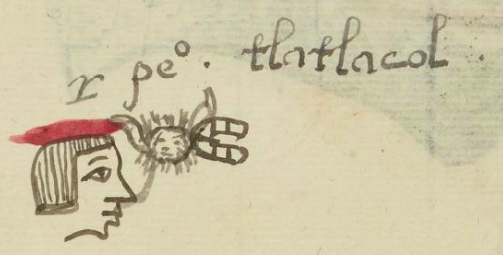Tlatlacol (MH577v)
This black-line drawing of the compound glyph for the personal name Tlatlacol (from Tlatlacole, “Sinner” or "Error Prone," attested here as a man’s name) shows a frontal view of a human head. Lots of short, messy lines come off the top and the bottom of the head. Perhaps two flames come off either side of the head, seemingly pointing to the verb, tlatla, to burn, which would be a phonetic indicator that would help the reader see that this person is a sinner or mistake-prone. What may be a set of teeth (tlantli) appears to the right of the head; if so, this would be a phonetic reinforcement.
Stephanie Wood
The concept of "sinner" appears to be a feature of Indigenous Christianity, as the work of Louise Burkhart has shown. The visual nature of this glyph may show European influence, too. See how it compares to Achiteotl, below. For the reading of teeth, see how teeth were attached to an eagle's head, below, in reference to the verb "to speak," tlahtoa.
Stephanie Wood
1560
Jeff Haskett-Wood
One could count the elements as including 1) the human head (the tlatlacole), 2) the messy lines coming off of it (mistakes, or the earlier thinking about tlatlacolli), 3) the flames (tlatla), and 4) the teeth [tla(ntli)].
sins, pecados

tlatlacol(li), sin, fault, defect, wrong, something evil, https://nahuatl.wired-humanities.org/content/tlatlacolli
tlatla, to get burned or to be on fire, https://nahuatl.wired-humanities.org/content/tlatla
tlan(tli), tooth or teeth, https://nahuatl.wired-humanities.org/content/tlantli
El Pecador
Stephanie Wood
Matrícula de Huexotzinco, folio 557v, https://www.loc.gov/resource/gdcwdl.wdl_15282/?sp=194&st=image
This manuscript is hosted by the Library of Congress and the World Digital Library; used here with the Creative Commons, “Attribution-NonCommercial-ShareAlike 3.0 License” (CC-BY-NC-SAq 3.0).




